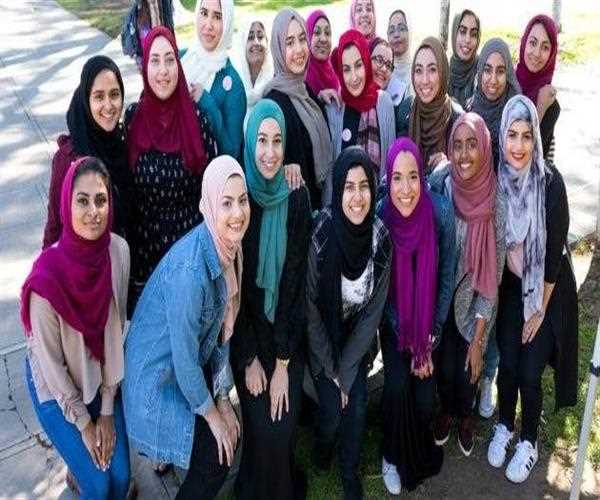Search here

17-Feb-2022 , Updated on 2/17/2022 11:49:16 PM
history of hijab in three stages
History of Hijab in Islam
In the early Islamic texts, the term hijab does not distinguish between veiling and seclusion and can mean either 'veil' or 'curtain the only verses in the Qur'an that specifically reference women's clothing are those promoting modesty, instructing women to guard their private parts and draw their scarves over their breast area in the presence of men. The contemporary understanding of the hijab dates back to Hadith when the 'verse of the hijab' descended upon the community in 627 CE. Veiling during Mohammad's lifetime
Historic pieces of evidence suggest that veiling was not introduced in Arabia by the last Prophet of Islam, but already existed there and was associated with high social status.
Sura 33:53 of QURAN, 'And when you ask [his wives] for something, ask them from behind a partition. That is purer for your hearts and their hearts.' O you who believe, do not enter the houses of the Prophet unless you are permitted for a meal, not (so early as) to wait for its preparation. But when you are invited, go inside. Then, once you have had the meal, just disperse, and (do) not (sit for long) being keen for a chat. This (conduct of yours) hurts the Prophet, but he feels shy of (telling) you (about it), but Allah is not shy of the truth. And when you ask anything from them (the blessed wives of the Prophet), ask them from behind a curtain. That is better for the purity of your hearts and their hearts. It is not allowed for you that you hurt Allah’s Messenger, nor that you ever marry his wives after him. Indeed, it would be an enormity in the sight of Allah. The verse descended upon the Islamic community in 627 CE and the term for donning the veil, darabat al-hijab, was used interchangeably with 'being Muhammad's wife'.
Later pre-modern history
The practice of veiling was borrowed from the elites of the Byzantine and Persian empires, where it was a symbol of respectability and high social status, during the Arab conquests of those empires. Reza Aslan argues that 'The veil was neither compulsory nor widely adopted until generations after Muhammad's death when a large body of male scriptural and legal scholars began using their religious and political authority to regain the dominance they had lost in society as a result of the Prophet's egalitarian reforms.
Modern history
'Western clothing largely dominated in Muslim countries in the 1960s and 1970s. For example, in Pakistan, Afghanistan, Iran, etc. There were demonstrations in Iran in March 1979, after the hijab law was brought in, decreeing that women in Iran would have to wear scarves to leave the house. However, this phenomenon did not happen in all countries with a significant Muslim population, in countries such as Turkey, there has been a decline in women wearing the hijab in recent years, although Turkey is becoming more conservative and Islamic.
The late-twentieth-century saw a resurgence of the hijab in Egypt after a long period of decline as a result of westernization. in the mid-1970s some college-aged Muslim men and women began a movement meant to reunite and rededicate themselves to the Islamic faith. This movement was named the Sahwah. Soon this movement expanded outside of the youth realm and became a more widespread Muslim practice. Women viewed this way of dress as a way to both publicly announce their religious beliefs as well as a way to simultaneously reject western influences of dress and culture that were prevalent at the time. Despite many criticisms of the practice of hijab being oppressive and detrimental to women's equality, many Muslim women view the way of dress to be a positive thing. It is seen as a way to avoid harassment and unwanted sexual advances in public and works to desexualize women in the public sphere in order to instead allow them to enjoy equal rights of completely legal, economic, and political status. This modesty was not only demonstrated by their chosen way of dress but also by their serious demeanor which worked to show their dedication to modesty and Islamic beliefs.
According to Muslim women, they consider that their beauty lies in their hair so they wear hijab. And second main reason is to cover their chest and shoulders. Hijab in detail we can say that it is a curtain, separation wall, and other words the anything that can hide masks and protects something
According to chapter 24 of Quran

“say to believe men that they should cast down their glances and guard their private parts. this is better for them” {24:30}https://quran.com/24/30-31
This is also known as the hijab of eyes. This commands men that they should not look lustfully at the women they are required to cast down their glances.
Then the next verse, ALLAH commands the prophet to address the women (24:31 “say to believing women that they should cast down their glances and guard their private parts and not display their beauty except what is apparent and they should place their Khimur over the bosoms”
It says that women to cast down their looks and guard their private parts and not reveal their adornment save to their husbands, or their fathers or the fathers of their husbands or of their own sons or the sons of their husbands or their brothers or the sons of their sisters or the women with whom they associate, or those that are in their service free of sexual interest or boys that are unaware of illicit matters pertaining to women. Nor should they stamp their feet on the ground in such a manner that their hidden ornaments become revealed.
Why do only Muslim women wear hijab why not men?
Hijab traditionally refers to the kind of dressing that a Muslim and particularly Muslim women are expected to have in some societies. Hijab just refers to the headscarf but among Muslim jurists, it refers to the full dressing of the woman. Islam is the way of life and prescribes certain minimum dressing that is considered based on the standards of modesty but at the same time accommodates culture so both men and women have a minimum amount of dressing that is considered appropriate for their biological natures and so.
For example, men are expected to cover everything between the navel and the knee, and for women, they are expected to cover everything except hands and face and the feet S and here we find differences of opinion among scholars. This means that if a Muslim man chooses to wear shorts, they must be long enough to cover the knees. A Muslim man’s clothing is also supposed to be loose enough so that you can’t see the details of his crotch.
It is unfortunate that not every Muslim man abides by these rules. Many of them wear tight jeans, for example. And no one makes a big deal out of it.
According to the most common interpretation, women are supposed to cover everything but their hands and their face. The clothing should be loose and conceal the figure. The head covering should be long enough to conceal the chest.
But here, something strange happens to many men. While wholly missing the primary burden of hijab first placed on them, men suddenly and magically discover the concept of hijab for women. It’s an amazing phenomenon I see all too often in my day job. For some reason, men think they can simply force women to observe hijab. Instead, the Quran and Prophet Muhammad are clear: in Islam, no such permission exists for men to force hijab on women.

Student
My name is Laxmi. I belong to Amritsar Punjab. I have done bcom (honours) with specialization in banking and finance. I have interests in politics and various issues emerging in the world. I understand the importance of keeping public informed about these issues. I am to cultivate meaningful relationships with subscribers. By doing this. Innovativeness and simplicity are the main essentials of every content and through this I want to keep my viewers informed and aware.
Join Our Newsletter
Subscribe to our newsletter to receive emails about new views posts, releases and updates.
Copyright 2010 - 2025 MindStick Software Pvt. Ltd. All Rights Reserved Privacy Policy | Terms & Conditions | Cookie Policy